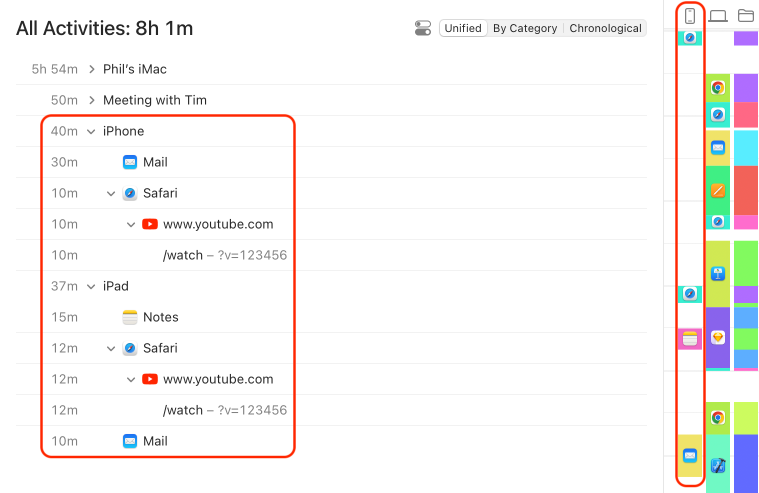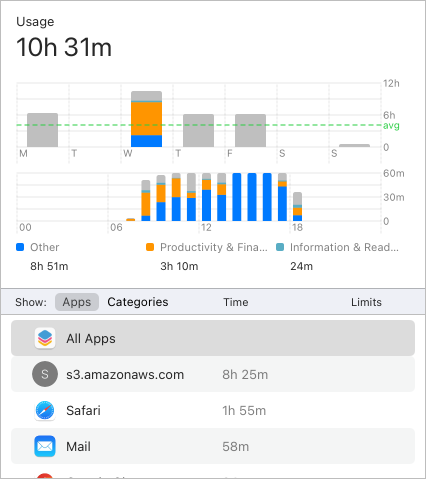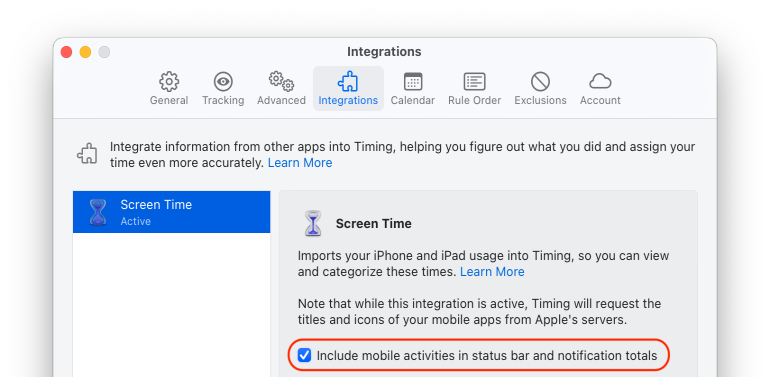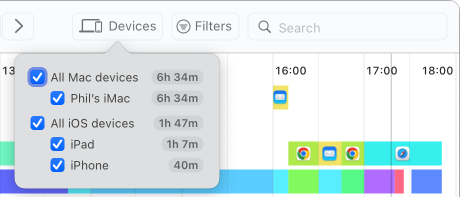Screen Time Integration
Please note: This feature is experimental and may stop working in future iOS or macOS updates. While it is currently working, it should be considered unreliable and may cease to function without notice.
Timing can import your iPhone and iPad usage from Screen Time. This feature lets you track your time spent on mobile devices just like your Mac usage, with the full functionality of Timing's timeline and activity list. Even Timing's rules are available to automatically categorize your mobile device usage.

Using Timing to display your Screen Time data has several advantages over the limited Screen Time views in the iOS and macOS system settings:
- A timeline that shows exactly when you used each device, and for what. No more guesswork, as opposed to Screen Time’s “hourly” granularity!
- Review any time range you want, rather than being limited to Screen Time’s day/week views.
- Archive Screen Time data for longer than the four weeks Apple allows.
- Categorize your mobile activities into projects using drag-and-drop.
- Timing can show even the full URLs of the websites you visited in Mobile Safari.
- You can quickly create manual time entries to annotate and categorize whole blocks of your mobile activity at once.
Read on for more information on how this feature works, how to set it up, and what to expect from it!
Table of Contents
Getting Started
To set up the Screen Time importer, open the Timing integration preferences and add the Screen Time integration. You will be asked to complete three steps:
- Enable Screen Time in System Settings on your Mac and enable sharing Screen Time data across devices. This is required so that your mobile Screen Time data can be synced to your Mac.
- Enable Screen Time on your mobile devices and enable sharing Screen Time data across devices. This is required for your mobile device to record data that Timing can import.
- Finally, grant Timing the "Full Disk Access" permission in System Settings. This is required for Timing to read your Screen Time database.
Once you have completed all these steps, Timing will start importing your Screen Time data in the background. This can take a few hours, so don't worry if the data doesn't show up right away. Once Timing has imported your Screen Time data, it will also notify you.
Once your mobile device usage has been imported, you can interact with these activities just like with any Mac activity recorded by Timing. You can view it on the timeline, drag it onto projects to categorize it, generate reports for it, and so on.
Limitations
While we have tried to make the import process as reliable as possible, it still depends on Apple's Screen Time service, which imposes a few limitations:
- The data that Timing imports can only be as accurate as the original data recorded by Screen Time. So, if you have noticed the data shown in the Screen Time settings on your mobile device to be notoriously unreliable, chances are that the data imported by Timing will reflect the same discrepancies.
- Timing can't import visited URLs from mobile Safari or any other browser. Previously, Timing could import the URLs of websites visited in mobile Safari, but this functionality is no longer available due to technical limitations.
- The Screen Time import relies on Apple's Screen Time and iCloud services to sync your data. This means that the initial import may take a while, and there might also be periods of delays later on, during which Timing takes a few hours to import your latest mobile activity. If you still aren't seeing any data whatsoever a few hours after setting up the Screen Time integration, please refer to the "Troubleshooting" section below.
- Screen Time retains only the last couple of weeks of data, so anything older than that can't be imported. However, Timing can retain activities permanently once it has imported them. So once you have imported activites, those will continue to be available in Timing even when they are no longer available in Screen Time.
- When you e.g. have Split Screen or Stage Manager enabled, time will be attributed towards only one of the visible apps at any given time.
- Timing can't deduct idle time from your Screen Time data, so it will simply import all your mobile device activity as "active".
- Some iOS apps might launch in the background to refresh their data. Screen Time will pick these up, even though you might not have used your device at that time. There's no way for Timing to recognize that this wasn't actual device usage, so it will import these activities as well. You can always delete these activities manually from your activity list; please see the "Troubleshooting" section below.
Troubleshooting / Frequently Asked Questions
If you are having trouble getting your Screen Time data imported into Timing or are seeing discrepancies between your actual usage and what Screen Time and/or Timing show, the following points might help you:
I am not seeing any Screen Time data in Timing, or the Screen Time data that I see is outdated. What can I do?
First, please double-check that everything is set up correctly:
- Make sure that you have enabled Screen Time in System Settings on your Mac and enabled sharing Screen Time data across devices.
- Make sure that you have enabled Screen Time on your mobile devices and enabled sharing Screen Time data across devices.
- Make sure that you have granted Timing the "Full Disk Access" permission in System Settings, and that you have enabled the Screen Time integration in Timing's preferences.
If you have everything set up correctly and are still not seeing any data after a few hours, please check whether you see the correct data from your mobile device in the Screen Time section in System Settings. If the data is not there, either, it can help to reboot both your Mac and your mobile device, then wait a few minutes for your activity to sync. We've also had a customer report tracking to resume more quickly after temporarily disabling Screen Time on their iPhone, renaming the iPhone in its Settings app, then re-enabling Screen Time.
Why does the Screen Time section in System Settings show different data than Timing?
There's a minor delay for Timing to import your mobile app usage, so the data shown in Timing might be slightly out of date. In addition, if you have asked Timing not to track your time on weekends and/or outside working hours, those times will show up in Screen Time, but Timing will not import them.
In addition, there are some fundamental aspects of how Screen Time works that can lead to discrepancies:
- Screen Time may end up double-counting time spent on websites for both the app and the website, while Timing will only count it once.
- Likewise, Screen Time might double-count time spent in e.g. Split Screen or Stage Manager, while Timing will only count it once.
- Screen Time sometimes also counts e.g. time when the lock screen was active or an application has been fetching data in the background, while Timing will not.
- If you use Safari to visit a website for which you also have the app installed (e.g. news outlets, Twitter, etc.), Screen Time might attribute that time towards the app, even though the website was actually visited using Safari, not the app. Timing will always attribute such times to Safari.
- Timing will attribute times spent in some in-app "mini-Safari" browsers towards Safari rather than the app itself.
- Sometimes, Screen Time can also show bogus data that is not plausible at all, such as the total time for all apps adding up to way more/less than what itself shows for the total. For example, here's a screenshot of Screen Time erroneusly reporting us to have spent more than 8 hours on
s3.amazonaws.com, not to mention the fact that the total time doesn't add up, either:
If you are seeing activity patterns that don't make sense even after taking all of the above into account, please feel free to report them to us.
I see brief periods of mobile activity in my timeline, even though I clearly didn't use my mobile device during that period. What is going on?
Some iOS apps might launch in the background to refresh their data, or notifications briefly cause your screen to turn on. Screen Time will pick these up, even though you might not have used your device at that time. And while Timing tries to filter out these "bogus" activities, it can't always detect them with 100% reliability.
If these entries bother you, you can always delete them from Timing's activity list:
- Click and drag onto the timeline to select the period during which these activities occurred.
- Then select the activities in question in the activity list.
- Right click them to open the context menu, then click "Delete".
Can I use different names than "iPhone" and "iPad" for my devices?
Yes! Simply click the device name in the legend on the left of the timeline, then enter a new name in the text field that appears.
The times from my mobile devices are messing up my daily time summaries. Is there a way to avoid that?
Yes! Just uncheck the option "Include mobile activities in status bar and notification totals" in the preferences of the Screen Time integration:

In addition, you can easily deselect your iOS devices via the device picker in the Timing toolbar to temporarily hide times from them:

Once that is done, Timing will continue to import your time from these devices, but you'll be able to view all your statistics for only the devices you are interested in.
Note that Timing remembers this selection across restarts, but you can of course re-select devices at any time.
How can I prevent some devices from getting imported? I only want to import iPad usage, not iPhone usage.
Simply create an exclusion rule for the device you don't want to import as explained in our knowledge base article on activity rules.